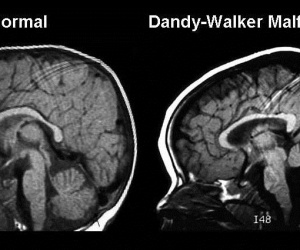Dandy-Walker Syndrome (Developmental Delay of Head): Symptoms & Its Treatment

Dandy-Walker Syndrome (DWS) is a rare group of congenital human brainmalformations. There are three subtypes which affect multiple organs to varying degrees, but the fundamental abnormalities involve the cerebellum which controls muscle coordination. Treatment may involve physical therapy,
- Symptoms often occur in early infancy with 80-90% of individuals becoming symptomatic in the first year of life.
- Most children have hydrocephalus with abnormally rapid increase in head circumference with bulging at the back of the skull.
- Development is often affected, particularly with delay in motor skills such as crawling and walking. Spastic paraplegia and seizures may be present. In 10-20% of individuals with DWS, signs and symptoms do not appear until late childhood or adulthood.
- the presentation is different and may be with signs of increased intracranial pressure, such as irritability, vomiting, headaches and convulsions.
- There may also be signs of cerebellar dysfunction, such as unsteadiness, lack of muscle co-ordination, or jerky movements of the eyes. One case report describes conduct disorder, hyperactivity, stereotypical movements and nocturnal enuresis in a 14 year-old. Some individuals with malformations characteristic of DWS have no symptoms and the diagnosis may be made incidentally because of neuroimaging done for another reason.
Investigations: The diagnosis of DWM can be made by antenatal ultrasound. MRI scan allows a detailed evaluation of DWM lesions and complications. MRI evaluation can then be used ante natally to confirm the diagnosis and to gain more detailed information.
Management:
- Treatment involves managing the associated problems – eg, seizure management. Hydrocephalus plays an important role in development of symptoms and neurological outcome
- This involves inserting a shunt. This may be to shunt the cyst (cystoperitoneal), the ventricles (ventriculoperitoneal), or both. Endoscopic procedures are also considered an acceptable alternative. Parents of children with DWS will benefit from genetic counselling if they intend to . have more children.
- Conservative management of patients with DWS includes occupational therapy, physiotherapy, speech therapy, specialized education, back brace and foot orthosis, with the goal of reducing falls and correcting gait abnormalities
Check out these links for relevant information: Speech therapy, occupational therapy, paediatric neuro
For more details contact
us on 📞9618906780
